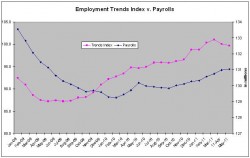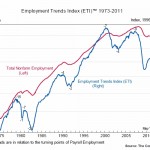 Bewildered about the direction employment is taking? Join the club.
Bewildered about the direction employment is taking? Join the club.
Between the official reports, the private ones, and all manner of surveys, you can pretty much find one that will agree with whatever opinion you hold. Or want to hold.
Last week, the U.S. Bureau of Labor Statistics said job growth in May was the smallest in eight months, stunning economists and investors who’s already lowered their expectations after being shocked when payroll processor ADP said the private sector added only 38,000 jobs in May.
Today, the Conference Board issued its monthly Employment Trends Index, which declined in May for the second consecutive month. This index is a composite of eight employment-related indicators, which are weighted to produce what the Conference Board says is “the only publicly available leading composite index for employment.”
 Historically, a drop in the Index has presaged job losses, usually by a matter of a few months. Click on the historical chart (below) to see the detail. The negative numbers on the chart indicate the number of months the Index turned down ahead of a decline in BLS job numbers.
Historically, a drop in the Index has presaged job losses, usually by a matter of a few months. Click on the historical chart (below) to see the detail. The negative numbers on the chart indicate the number of months the Index turned down ahead of a decline in BLS job numbers.
The top chart plots the last 29 months. Does the April-May downturn in the Index mean job losses are ahead? That’s not what most economists are saying. Nor is that what the surveys I’m seeing say. In fact, most of the employment surveys are fairly optimistic.
Dice Holdings, for example, sent out a report last week that flatly declares: “America’s hiring managers and recruiters are forecasting healthy job growth for the remainder of this year.”
Don’t think this applies to just IT professionals. For while the techie job board Dice.com is part of Dice Holdings, the company also owns several other nice professional sites covering finance, healthcare, energy ,and jobs requiring a security clearance.
Half of the 1,000 employers and recruiting firms who responded to the Dice survey last month said they expected to hire more professionals in the second half of the year than in the first. Almost a quarter (23 percent) of the respondents expect to bump their hiring by at least 21 percent.
A few months ago, CareerBuilder’s quarterly jobs forecast predicted that almost 30 percent of employers would add full-time permanent positions during this quarter.
That tracked with the optimism shown by CEOs. The Conference Board’s survey of CEO confidence rose in the first quarter, and now stands at 67. When it issued the report early in April, The Conference Board said, “Half of all CEOs anticipate an increase in employment levels in their industry, up significantly from 30 percent a year ago.”
SHRM, too, was upbeat about the current quarter, reporting in its quarterly jobs survey a few months ago that 57 percent of the HR professionals surveyed were optimistic about jobs growth.
More recently, the Philadelphia Federal Reserve’s Survey of Professional Forecasters predicted the economy would add about 191,100 jobs per month this quarter and 194,500 jobs per month for the third quarter of the year. It’s going to be tough to hit the second quarter number since April and May together only added 286,000 jobs.
But even after lowering estimates for the balance of the year, the Fed is still optimistic enough to have lowered the predicted unemployment rate. Now, it says unemployment will likely be around 8.5 percent by the end of the year.
Beyond.com distributed a quarterly employment report last week that talked about overall improvement in hiring during the first quarter of the year. It says 74 percent of the employers posting jobs to the Beyond.com network were looking for full-time workers, a 6 percent increase over the last quarter of 2010.
The report does note some trouble spots for skilled job seekers:
One trend that has emerged in the midst of the job market recovery is a gap between open positions and job seeker skills. On one hand, many of the positions being created are in low-wage industries, meaning many job seekers will be overqualified or uninterested.
At the same time, some niche industries find themselves dealing with a dearth of qualified candidates because these positions require such specialized skills.
SHRM’s June LINE report makes the same observation, telling the story with this headline: “Modest Job Growth Continues in June; Recruiting Difficulty Remains Elevated.” The report says manufacturing jobs will increase, while service-sector hiring will slow somewhat. At the same time, the report notes that recruiters are having increasing difficulty finding the candidates they want.
What’s one to make of all these reports? Says the chief economist at Goldman Sachs in a note to clients: “We are still reluctant to take the deceleration entirely at face value, partly because many of the signs of ‘healing’ in the private sector that encouraged us in late 2010 are still visible.”
Notes Accenture’s Rich Bergmann, global lead at Accenture’s manufacturing group: “People are being conservative. They’re not betting the farm, they’re not building $400 million manufacturing facilities, but they are looking to hire more people and (employ) better technology.”